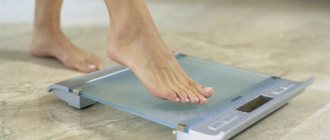Why do they use deception on scales in stores?
The natural quality of any person is the desire to earn income from their activities. The realization of this desire occurs differently for everyone. For some sellers, the ability to manipulate scales is a required science. This allows you to make more money by selling less goods.
Here the order of actions has evolved over centuries. Any dishonest employee, standing behind a store counter or sitting in a street tent, knows what to do. He has mastered all the techniques so much that he performs them automatically. The main thing is to get increased income at the expense of inattentive, careless or naive clients.
How to avoid being deceived
When purchasing groceries, you need to focus your interest not only on the quality of the product, but also on the behavior of the store employee. To better understand the instrument readings, wait until the needle stops completely or until the numbers on the electronic menu stop jumping.
ATTENTION! You can buy yourself an electronic scale specifically for household purposes. They are truly an irreplaceable thing in every household, and they can be used to double-check the weight of products. In this way, you can figure out the store that is cheating and never go there again.
When going to the market, you can take a proven steelyard with you and simply hold it in your hands while shopping. A psychological factor can work here: seeing an experienced buyer in front of him, the seller will not have the desire to deceive or argue.
It is better to know the possible tricks and tricks of unscrupulous sellers so as not to be deceived. We hope that this article will be useful and help avoid possible misunderstandings and unnecessary waste of money.
How to cheat on regular scales
The scales used in the pre-electronic era were varied.
Spring steelyards are often used in markets. Officially, they have long been prohibited in trade, but they are still used. With their help, it is very easy to increase the measured weight of a product compared to the actual weight. It is enough to make a sharp upward movement with your hand, and the readings increase, according to the laws of physics. Do not make a purchase from a seller with a steelyard!
In a similar way, increase the weight on lever plate scales. You can throw a bag of groceries at them and the readings will increase.
For them, lightweight weights are used, which are specially made by masters of this craft. A cavity is drilled into the weight and closed with a special washer, and then masked. A 1 kg weight decreases by approximately 100 g, and a 2 kg weight decreases by 200 g.
A special removable handle is attached to the scales with a round dial, with the help of which a false zero is set. This kind of body kit is very difficult to detect. This method adds up to 500 g to your purchase, and this figure can be adjusted. Once the weighing is completed, the handle is discreetly removed and hidden.
Sometimes a fishing line is attached to the scales, the end of which reaches the ground. You can influence it with your foot, then the readings increase.
There is also a manual kit, when a narrow adhesive tape is glued to the bowl, which can be pulled. When the procedure is completed, the tape is removed.
A magnet is often used. It is attached to the bottom of the bowl, or a pack of cigarettes with it inside is placed next to the scales. Now there are strong magnets on sale, only the size of a five-kopeck coin. Thanks to this technique, the device shows a higher value.
Another way is to change the tilt of the device. An imperceptible change in the height of two of the four legs will bring up to 100 g of additional weight.
Mechanical scales must be calibrated before use. There are corresponding instructions for this. Using this procedure, a skilled person can imperceptibly distort the readings. For example, according to the instructions, you need to place a 1 kg weight on the bowl. The device remembers this data, and further weighing will give the correct result. But the seller, instead of a 1 kg weight, puts a 900 g pack of cereal, and the device perceives this as 1 kg. Next, accordingly, there will be a systematic body kit of 100 g.
Universal instructions for electronic scales.
February 18, 2020
why calibration is needed • instructions • universal instructions • instructions for scales • emptying containers • counting button
Universal instructions for portable scales.
Precautionary measures:
- Never overload the scale (do not use more weight than is intended for this model.
- Avoid any contact of the device with high or low temperatures; electronic scales work best at normal room temperature. Always allow the scale to acclimate to normal room temperature for at least one hour before use.
- If you are going to calibrate the scale, keep it turned on for 30-60 seconds before calibration to allow the internal components to prepare for operation.
- Keep your scale clean. Dust, dirt, humidity, vibration, air currents and proximity to other electronic equipment can adversely affect the reliability and accuracy of the scale.
- Handle with care: carefully place items to be weighed on the scale platform and press the control buttons lightly. Try to avoid sharp pressure, great force, or rough handling, as this may damage the internal sensors.
- Avoid shaking, hitting or dropping the scale. This is a precision instrument and must be handled with care.
- You need to work with weights on a flat, static surface.
Getting started with electronic scales:
- Place the scale on a flat, static surface.
- Open the lid (if equipped).
- Turn on the scale by pressing the “ I/O ” or “ On/Off ” button.
- Turn on/off the backlight (if required) by pressing the “ LIGHT ” button (this function may not be present in all models).
- Wait until zeros (0.00) are displayed on the display, use the “ M ” or “ Unit ” button to select the desired unit of measurement.
- Carefully place the items to be weighed on the weighing platform.
- Wait until the scale displays stable readings.
- To count the number of identical items, use the “ PCS ” button (this function may not be present in all models).
- Turn off the scales using the “ I/O ” or “ On/Off ” button.
Tara function key "T":
- Turn on the scale as described above.
- Place the "container" on the platform.
- Press the TARE key and wait until [0.00] is displayed
- After this, you can place the items to be weighed on the scales.
Counting function "PSC" key (not available on all models):
- Press and hold the "PCS" button (count button) for two seconds until "100" appears.
- Press the "MODE" button (select weight units) and you will see "25, 50, 75, 100". Please select the number of items to be weighed.
- Then place the appropriate number of items that you intend to consider as a sample.
- Then press "PCS" (count button) to confirm.
- Remove the sample.
- You can now place the items you want to count in the center of the platform and the display will show their number.
Calibration function key “M” (MODE) or “CAL”:
- Turn on the scale by pressing “ON/OFF” (on/off button).
- Press and hold the "M" (MODE) or "CAL" (calibration function) button until the display shows "CAL".
- Press "M" (MODE) or "CAL" (calibration function) again, "CAL" will flash and then show the weight to be placed on the platform.
- Place the desired weight on the platform and wait 3 to 4 seconds until “PASS” appears on the screen.
- Remove the weight and press "ON/OFF" (on/off button) to turn off the scale.
This completes the calibration.
If calibration is unsuccessful, the screen will display “FAIL.”
Please repeat steps 1-5 of the calibration function.
Thank you for purchasing electronic scales on the website Planetavesov.ru
Return to list of publications
Ways to cheat on electronic scales
In the age of electronics, it is believed that complex technology cannot be deceived. She needs to be trusted. Is it so?
Human ingenuity is inexhaustible, especially when it comes to personal gain. Sellers immediately learned how to handle complex devices “correctly.” There were many options.
An almost weightless plastic bag is secured to the work surface. The buyer does not object because he believes that “it’s cleaner this way.” In fact, it costs nothing for the seller, who is superior in dexterity to the illusionist, to tug lightly for this package. Increased pressure will create increased weight.
Another variant. The seller has a piece of adhesive tape stuck to his finger. When a product is placed on the scale, the belt simultaneously touches the bowl. Just move it a little and the result will be achieved. Then the tape is quickly and discreetly peeled off.
The design of electronic scales includes hygienic plastic pads on the working surface. The scales are calibrated along with them. You can carry out this procedure so that the linings are included in the weight of the goods.
Magnets are used not only in mechanical lever scales, but also in electronic ones. They place it where it is not visible to the buyer, that is, at the back.
Correct calibration
The trick with electronic scales is that they have different settings. The main one is the one in which the scales remember the correspondence of the signal from the load cell to the actual weight of the product. The procedure is called "calibration".
The easiest way to cheat is to put 900 grams on the scale and write it down as a kilogram. This is done differently in different scales, but the essence is the same. And most importantly, if something happens, what claims can there be against the seller? If, in the event of exposure, it is presented as, for example, a banal failure of electronics?
Why know your correct weight?
What is a weighing error? This is the wrong weight. What is incorrect weight? In some cases, this is a full-fledged tragedy. Suppose a lady is carefully and seriously losing weight: she goes on a diet, exercises, speeds up her metabolism, etc. Of course, in this case it is necessary to weigh herself periodically to determine whether there is a result from her weight loss efforts, and if so, what kind exactly. Maybe the girl didn’t lose weight because of her efforts, but rather gained weight. Or – her weight froze in place. Well, there are such cases.
And now she steps on the electronic floor scales (and there are almost no other scales left now - for example, mechanical ones). And the scales display a strange, implausible, fantastic, impossible, illogical result. Of course, the lady falls into a state of shock and begins to reproach herself for improper fasting or insufficient sports efforts, or even the coach for his incorrect recommendations... In general, everyone gets it.
Meanwhile, the lady’s despair in many cases is completely in vain. After all, what are scales (even if they are electronic)? This is a mechanism, and like any mechanism, they tend to fail periodically. That is, showing the wrong weight in one direction or another.
This is one of the reasons for incorrect weight when weighing. And there is another reason - the wrong behavior of the lady herself. That is, she did not step on the scale according to the rules, hence the depressing result. But what are these rules, and what are the lady’s mistakes? Oh, there's a lot to talk about!
When you need to weigh less
Here are some situations when you want to fool the scales and show an underestimated result:
- Sports events. Before important competitions, participants undergo a control weigh-in. At this time, it is important that the weight does not exceed the permissible number of kilograms. After all, even half a kilogram of excess weight can become a real obstacle to participation in a sporting event.
- Visit doctor. When undergoing treatment from a gynecologist or therapist, it is important to follow the recommendations of specialists. But it is not always possible to do this in full. In order to show the best results at the appointment, you want to reduce your weight as much as possible.
Attention! Misleading the attending physician about underweight, first of all, can negatively affect the health of the patient himself.
A little about electronic varieties
Electronic floor device
Now there are only two types of weighing devices for any purpose: mechanical and electronic. Mechanical ones are not distinguished by high accuracy - manufacturers do not hide the fact that in such devices discreteness of up to one kilogram is permissible. With electronic devices everything is different. It’s also worth paying attention to smart scales for home use. Despite the similarity in the structure of the mechanism, electronic devices provide more accurate results. This can be explained by the elementary display of the value on the display - indicating kilograms and grams, which cannot be seen on the scale of mechanical instruments, which leads to reduced discreteness - from 100 to 500 grams.
Read about the design of mechanical floor scales here.
Electronic diagnostic tools
Simplified electronic models have a built-in measuring spring, the results of which are displayed on the display when weighing. More modern and improved models use a voltage sensor through which an electric current is passed. As soon as a person stands on the platform, the sensor is pulled, and the generated electrical signal displays the changed data on the display. Such models use only electronics; the advantages include the ability to obtain additional information about the body.










